[English] 日本語
 Yorodumi
Yorodumi- PDB-7mqo: The insulin receptor ectodomain in complex with a venom hybrid in... -
+ Open data
Open data
- Basic information
Basic information
| Entry | Database: PDB / ID: 7mqo | ||||||
|---|---|---|---|---|---|---|---|
| Title | The insulin receptor ectodomain in complex with a venom hybrid insulin analog - "head" region | ||||||
 Components Components |
| ||||||
 Keywords Keywords | HORMONE / TOXIN / insulin / receptor / venom / cone snail | ||||||
| Function / homology |  Function and homology information Function and homology informationregulation of female gonad development / positive regulation of meiotic cell cycle / insulin-like growth factor II binding / positive regulation of developmental growth / male sex determination / insulin receptor complex / insulin-like growth factor I binding / positive regulation of protein-containing complex disassembly / insulin receptor activity / exocrine pancreas development ...regulation of female gonad development / positive regulation of meiotic cell cycle / insulin-like growth factor II binding / positive regulation of developmental growth / male sex determination / insulin receptor complex / insulin-like growth factor I binding / positive regulation of protein-containing complex disassembly / insulin receptor activity / exocrine pancreas development / dendritic spine maintenance / cargo receptor activity / insulin binding / adrenal gland development / PTB domain binding / negative regulation of glycogen catabolic process / neuronal cell body membrane / positive regulation of nitric oxide mediated signal transduction / negative regulation of fatty acid metabolic process / negative regulation of feeding behavior / Signaling by Insulin receptor / IRS activation / regulation of protein secretion / Insulin processing / positive regulation of peptide hormone secretion / positive regulation of respiratory burst / amyloid-beta clearance / negative regulation of acute inflammatory response / Regulation of gene expression in beta cells / alpha-beta T cell activation / positive regulation of receptor internalization / regulation of embryonic development / insulin receptor substrate binding / positive regulation of dendritic spine maintenance / Synthesis, secretion, and deacylation of Ghrelin / negative regulation of respiratory burst involved in inflammatory response / epidermis development / activation of protein kinase B activity / negative regulation of protein secretion / protein kinase activator activity / negative regulation of gluconeogenesis / positive regulation of insulin receptor signaling pathway / positive regulation of glycogen biosynthetic process / fatty acid homeostasis / Signal attenuation / FOXO-mediated transcription of oxidative stress, metabolic and neuronal genes / negative regulation of lipid catabolic process / positive regulation of lipid biosynthetic process / heart morphogenesis / negative regulation of oxidative stress-induced intrinsic apoptotic signaling pathway / transport across blood-brain barrier / regulation of protein localization to plasma membrane / phosphatidylinositol 3-kinase binding / nitric oxide-cGMP-mediated signaling / transport vesicle / COPI-mediated anterograde transport / positive regulation of nitric-oxide synthase activity / Insulin receptor recycling / negative regulation of reactive oxygen species biosynthetic process / positive regulation of brown fat cell differentiation / insulin-like growth factor receptor binding / NPAS4 regulates expression of target genes / dendrite membrane / neuron projection maintenance / endoplasmic reticulum-Golgi intermediate compartment membrane / positive regulation of mitotic nuclear division / receptor-mediated endocytosis / Insulin receptor signalling cascade / positive regulation of glycolytic process / positive regulation of cytokine production / endosome lumen / positive regulation of long-term synaptic potentiation / acute-phase response / positive regulation of protein secretion / positive regulation of D-glucose import / learning / insulin receptor binding / positive regulation of cell differentiation / Regulation of insulin secretion / wound healing / positive regulation of neuron projection development / receptor protein-tyrosine kinase / hormone activity / negative regulation of protein catabolic process / regulation of synaptic plasticity / caveola / cellular response to growth factor stimulus / receptor internalization / positive regulation of protein localization to nucleus / Golgi lumen / vasodilation / cognition / memory / male gonad development / glucose metabolic process / cellular response to insulin stimulus / positive regulation of nitric oxide biosynthetic process / insulin receptor signaling pathway / late endosome / cell-cell signaling Similarity search - Function | ||||||
| Biological species |  Homo sapiens (human) Homo sapiens (human) | ||||||
| Method | ELECTRON MICROSCOPY / single particle reconstruction / cryo EM / Resolution: 3.4 Å | ||||||
 Authors Authors | Blakely, A.D. / Xiong, X. / Kim, J.H. / Menting, J. / Schafer, I.B. / Schubert, H.L. / Agrawal, R. / Gutmann, T. / Delaine, C. / Zhang, Y. ...Blakely, A.D. / Xiong, X. / Kim, J.H. / Menting, J. / Schafer, I.B. / Schubert, H.L. / Agrawal, R. / Gutmann, T. / Delaine, C. / Zhang, Y. / Artik, G.O. / Merriman, A. / Eckert, D. / Lawrence, M.C. / Coskun, U. / Fisher, S.J. / Forbes, B.E. / Safavi-Hemami, H. / Hill, C.P. / Chou, D.H.C. | ||||||
| Funding support | 1items
| ||||||
 Citation Citation |  Journal: Nat Chem Biol / Year: 2022 Journal: Nat Chem Biol / Year: 2022Title: Symmetric and asymmetric receptor conformation continuum induced by a new insulin. Authors: Xiaochun Xiong / Alan Blakely / Jin Hwan Kim / John G Menting / Ingmar B Schäfer / Heidi L Schubert / Rahul Agrawal / Theresia Gutmann / Carlie Delaine / Yi Wolf Zhang / Gizem Olay Artik / ...Authors: Xiaochun Xiong / Alan Blakely / Jin Hwan Kim / John G Menting / Ingmar B Schäfer / Heidi L Schubert / Rahul Agrawal / Theresia Gutmann / Carlie Delaine / Yi Wolf Zhang / Gizem Olay Artik / Allanah Merriman / Debbie Eckert / Michael C Lawrence / Ünal Coskun / Simon J Fisher / Briony E Forbes / Helena Safavi-Hemami / Christopher P Hill / Danny Hung-Chieh Chou /     Abstract: Cone snail venoms contain a wide variety of bioactive peptides, including insulin-like molecules with distinct structural features, binding modes and biochemical properties. Here, we report an active ...Cone snail venoms contain a wide variety of bioactive peptides, including insulin-like molecules with distinct structural features, binding modes and biochemical properties. Here, we report an active humanized cone snail venom insulin with an elongated A chain and a truncated B chain, and use cryo-electron microscopy (cryo-EM) and protein engineering to elucidate its interactions with the human insulin receptor (IR) ectodomain. We reveal how an extended A chain can compensate for deletion of B-chain residues, which are essential for activity of human insulin but also compromise therapeutic utility by delaying dissolution from the site of subcutaneous injection. This finding suggests approaches to developing improved therapeutic insulins. Curiously, the receptor displays a continuum of conformations from the symmetric state to a highly asymmetric low-abundance structure that displays coordination of a single humanized venom insulin using elements from both of the previously characterized site 1 and site 2 interactions. | ||||||
| History |
|
- Structure visualization
Structure visualization
| Movie |
 Movie viewer Movie viewer |
|---|---|
| Structure viewer | Molecule:  Molmil Molmil Jmol/JSmol Jmol/JSmol |
- Downloads & links
Downloads & links
- Download
Download
| PDBx/mmCIF format |  7mqo.cif.gz 7mqo.cif.gz | 256.8 KB | Display |  PDBx/mmCIF format PDBx/mmCIF format |
|---|---|---|---|---|
| PDB format |  pdb7mqo.ent.gz pdb7mqo.ent.gz | 199 KB | Display |  PDB format PDB format |
| PDBx/mmJSON format |  7mqo.json.gz 7mqo.json.gz | Tree view |  PDBx/mmJSON format PDBx/mmJSON format | |
| Others |  Other downloads Other downloads |
-Validation report
| Arichive directory |  https://data.pdbj.org/pub/pdb/validation_reports/mq/7mqo https://data.pdbj.org/pub/pdb/validation_reports/mq/7mqo ftp://data.pdbj.org/pub/pdb/validation_reports/mq/7mqo ftp://data.pdbj.org/pub/pdb/validation_reports/mq/7mqo | HTTPS FTP |
|---|
-Related structure data
| Related structure data |  23949MC  7mqrC  7mqsC M: map data used to model this data C: citing same article ( |
|---|---|
| Similar structure data | |
| EM raw data |  EMPIAR-10736 (Title: Cryo-EM of the human insulin receptor ectodomain in complex with an insulin analog with truncated B chain and enlongated A chain EMPIAR-10736 (Title: Cryo-EM of the human insulin receptor ectodomain in complex with an insulin analog with truncated B chain and enlongated A chainData size: 11.7 TB Data #1: Unaligned multi-frame micrographs (40 e-/A2 dose) [micrographs - multiframe] Data #2: unaligned micrographs (60 e-/A2 dose) [micrographs - multiframe]) |
- Links
Links
- Assembly
Assembly
| Deposited unit | 
| |||||||||||||||||||||||||||||||||||||||||||||||||||||||||||||||||||||||||||||||||||||||||||||||||||||||||||||||||||||||||||
|---|---|---|---|---|---|---|---|---|---|---|---|---|---|---|---|---|---|---|---|---|---|---|---|---|---|---|---|---|---|---|---|---|---|---|---|---|---|---|---|---|---|---|---|---|---|---|---|---|---|---|---|---|---|---|---|---|---|---|---|---|---|---|---|---|---|---|---|---|---|---|---|---|---|---|---|---|---|---|---|---|---|---|---|---|---|---|---|---|---|---|---|---|---|---|---|---|---|---|---|---|---|---|---|---|---|---|---|---|---|---|---|---|---|---|---|---|---|---|---|---|---|---|---|---|
| 1 |
| |||||||||||||||||||||||||||||||||||||||||||||||||||||||||||||||||||||||||||||||||||||||||||||||||||||||||||||||||||||||||||
| Noncrystallographic symmetry (NCS) | NCS domain:
NCS domain segments:
|
 Movie
Movie Controller
Controller


 UCSF Chimera
UCSF Chimera


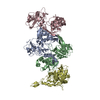

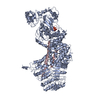
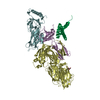

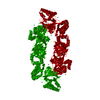
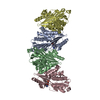
 PDBj
PDBj




















